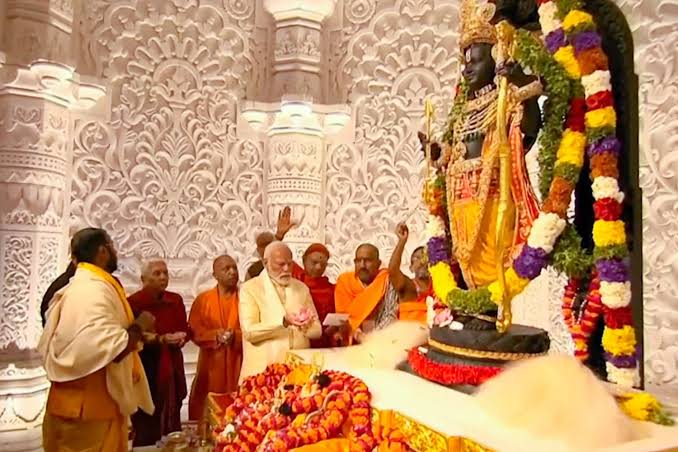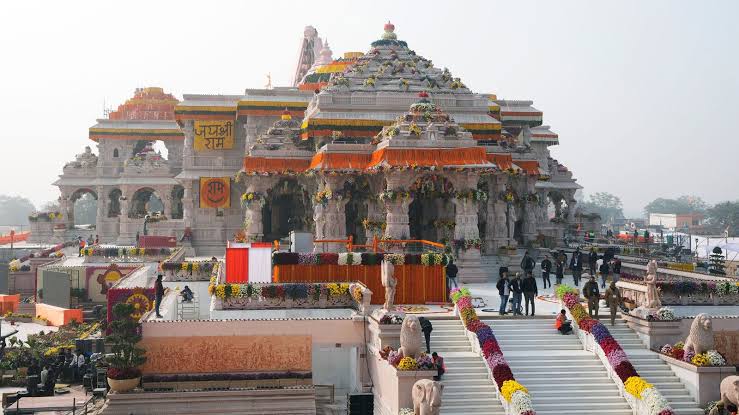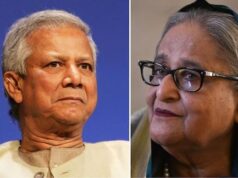Ram Temple finally rebuilt at original site and dedicated to the Nation

Prime Minister, performs rituals during the opening of a temple dedicated to Lord Ram in Ayodhya, on Jan. 22, 2024
Prime Minister Narendra Modi dedicated the Ram Janambhumi temple that was built in its original place, where it had been destroyed by a military Commander of the Mughal invader Babur in 1528. Thus it has been not only a national triumph for the Hindu majority but also a political triumph for the most popular leader of the World who is seeking to transform the country into the top most economy of the world.
The temple, dedicated to Lord Ram, sits on a site in the at least 6000 thousand year old city of Ayodhya, if not more, where a mosque had been deliberately erected by Mir Baqi a military Commander of the Mughal invader Babur in 1528. The site of this unused, depleted mosque had been in legal dispute since 18th Century and was torne down three decades ago by Karsevaks. Thus this building of the temple after 500 years is akin to Israelis finally getting back to Jerusalem.
The Bharatiya Janata Party and various Hindu groups have seen the temple’s consecration as central to their vision of reclaiming India’s national pride, which was brutally suppressed during centuries of Mogul rule and British colonialism. Also the opening of the temple — which millions of Hindus worship — has exposed the main opposition Congress Party and now without question, people already highly impressed by the infrastructural development and rising economy, are determined to vote the prime minister to a record third successive term in elections expected this spring.
Though some critics with half baked knowledge of tradition and customs of Sanatan Dharma, accuse Modi of a hurried opening of the still incomplete premises of the temple to woo voters.
And analysts say the ceremonial display rivalling any such event in Europe or USA, marks a key moment in India’s history, showing the extent to which the nation has been galvanized. Though some criticize this as ending the line between Govt and nation, they forget the British Coronation in Church and Thanks Giving ceremony of US President in te White House.

On Monday, the prime minister, dressed in a traditional kurta tunic, led the opening ceremony as Hindu priests chanted hymns inside the temple’s inner sanctum, where a 1.3-meter (4.3-foot) stone sculpture of Lord Ram was installed last week. A priest blew a conch to mark the temple’s opening, and Modi placed a lotus flower in front of the black stone statue, decked in intricate gold ornaments and holding a golden bow and arrow. He later prostrated before it like a true devotee. He had also purified himself for the ceremony through a 11 days fast, strictly as per vedic rituals.
Nearly 7,500 people, including elite industrialists, politicians and movie stars, witnessed the ritual on a giant screen outside the temple as a military helicopter showered flower petals.
“Our Lord Ram has arrived after centuries of wait,” Modi said in a speech after the ceremony, receiving resounding applause from thousands of attendees. He said the temple was built after “countless sacrifices” and is testament to a rising India “breaking the shackles of slave mentality.”
“Jan. 22, 2024, is not merely a date but marks the dawn of a new era,” Modi said.
The UP state government led by CM Yogi ensured that the event was a national occasion by organizing live screenings across the country and closing offices for a day. The Central Govt too declared a half day for its offices. Saffron flags — the color of Hinduism — adorned the streets of various cities where BJP party workers had gone door to door handing out pamphlets.
Television news channels ran nonstop coverage of the event. Some movie theaters broadcast it live with complimentary popcorn. Many states declared the day a public holiday. In a rare step, stock and money markets were closed for the day.
“Ram Rajya (rule) begins,” a TV news headline said. Ram Rajya is a Sanskrit phrase that means just and ethical governance.
Modi has been the face of an unprecedented and unapologetic fusion of dharma with governance and development in India. Ahead of the temple opening, he set the tone by visiting numerous Ram temples over 11 days as part of a Hindu ritual.
Critics see Monday’s ceremony as the start of the election campaign for Modi, an avowed nationalist for whom India comes first and one of India’s most consequential leaders.
“Prime ministers prior to Modi have also been to temples, been to other places of worship, but they went there as devotees. This is the first time that he went there as somebody who performed the ritual,” said Nilanjan Mukhopadhyay, an expert in Hinduism and author of a book on Modi.
The temple, located at one of India’s most important religious sites, is surely going to buoy Modi’s returning to power by drawing on the inner sentiments of Hindus, who make up 80% of India’s population of 1.4 billion.
Ayodhya, once crowded with tightly packed houses and rundown stalls, has undergone an elaborate makeover in the lead up to the temple’s inauguration. Narrow roads have been turned into a four-lane pilgrimage route leading to the temple, tourists are arriving at a new airport and sprawling railway station, and major hotel chains are building new properties. The entire region is going to benefit and would soon be rivalling Vatucan, Mecca and Jerusalem in religious tourism.
Jubilant devotees from across the country have arrived to celebrate the opening, with groups of them dancing to religious songs that blare from speakers on roads bedecked with flowers. Some 20,000 security personnel and more than 10,000 security cameras have been deployed.
Officials say the temple, a three-story structure made of pink sandstone, will open to the public after the ceremony and they expect 100,000 devotees to visit daily.
“I am here to see history unfolding before our eyes. For centuries, the story of Lord Ram has resonated in the hearts of millions,” said Harish Joshi, who arrived in Ayodhya from Uttarakhand state four days before the ceremony.
But not all are rejoicing. Some top leaders from India’s main opposition Congress party also boycotted the event, with many accusing Modi of exploiting the temple for political points.
Neighboring Pakistan Govt which has been under military dictatorship for most of its existence and already vaquished its miniority Hindu and Christain population had te gall to comment that “ a temple built on the site of a demolished mosque would remain a blot on India’s democracy.”
“There is a growing list of mosques (in India) facing a similar threat of desecration and destruction,” Pakistan’s Foreign Ministry said in a statement. It urged the international community to help save Islamic heritage sites in India from “extremist groups” and ensure that minority rights are protected….Pakis seem to have forgotten why they demanded a division of the Subcontinent for a separate country, so now what’s their problem?
Built at an estimated cost of INR 1800 crores — raised through donations from the public that has crossed 3700 crores — and spread over nearly 3 hectares (7.4 acres), the temple lies at the original birth site of Lord Ram as determined by scriptures atop the debris of the 16th-century Babri Mosque built forcibly by Babur’s military Commander over temple ruins, which was finally razed to the ground in 1992 by Hindu karsevaks.
The European Jesuit missionary Joseph Tiefenthaler, who lived and worked in India for 38 years (1743–1785) and wrote numerous works about India, visited Ayodhya in 1767. Johannesburg Bernoulli translated his work Descriptio Indiae (in Latin) into French, published in 1786. According to this account, Aurangzeb (r. 1658–1707) had demolished the Ramkot fortress, including the house that was considered as the birthplace of Rama by Hindus. A mosque with three domes was constructed in its place. However, he also noted, “others say that it was constructed by ‘Babor’ [Babur]”. The Hindus continued to offer prayers at a mud platform that marked the birthplace of Rama Tiefenthaler was well-versed in Persian and Sanskrit, having written a Sanskrit–Persian dictionary, and other works in Persian. Evidently he did not find an inscription on the walls of the mosque stating that it was constructed under Babur’s orders. He “emphatically attributed it to Aurangzeb, and Babur’s name is carried by a few persons”.
The mosque’s demolition triggered bloody riots across India that killed 2,000 people. The dispute ended in 2019 when, in a full bench majority decision with a muslim judge too, India’s Supreme Court called the mosque’s demolition “an egregious violation” of the law but granted the site to Hindus while giving Muslims a different plot of land.
At least three historical mosques in northern India are embroiled in court disputes following claims which say they were built over temple ruins. Hindu organizations have also filed cases in courts seeking ownership of hundreds of historic mosques which have been forcibly built during Moghul rule of Aurangzeb.




